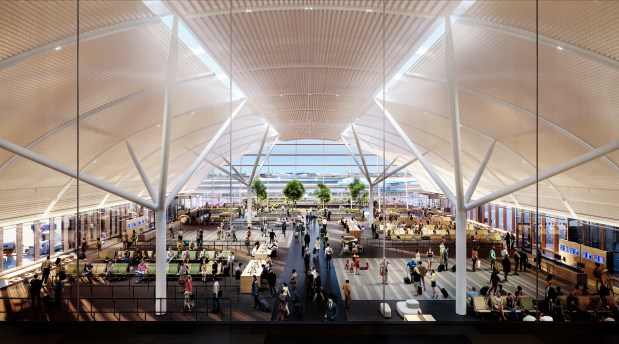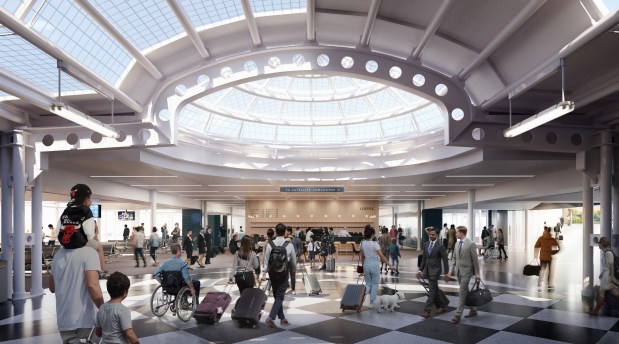O’Hare International Airport’s sprawling terminal expansion took a step forward Tuesday when Mayor Brandon Johnson shared new plans for the project’s first satellite concourse.
The announcement shows the growing momentum of the long-awaited rebuild, which will see the replacement of Terminal 2 with a new global terminal and the addition of two satellite concourses. But many questions remain about the timing, cost and design of the delayed expansion project.
“This is a once-in-a-generation expansion, the modernization of O’Hare,” Johnson said at a news conference. “Investing in our airports is investing in all of our communities. »
The satellite’s designs include high rounded ceilings, garden seating areas, and tree-shaped support columns designed to make visitors feel like they’re “moving through an orchard,” a nod to the The airport’s original name, Orchard Field, said Ryan Culligan, design director. at the architectural firm Skidmore, Owings & Merrill.
The project was designed with tones “inspired by Midwestern landscapes” and is “beautiful, impactful and practical,” he added.
Early work on the satellite began last year, said Jamie Rhee, commissioner of the Chicago Department of Aviation. The design is about 30 percent complete for the two planned satellites, the new global terminal and the underground tunnels that connect them to the rest of the airport, she said.
Rhee declined to share his estimates on when the overall terminal expansion will be completed, citing the need to minimize disruption to carriers. A gradual implementation will be planned “over the coming months”, she added.
“This is a very complex construct, right in the heart of their operations, and we need them to make money, we need them to keep operating,” Rhee said. “But our work is progressing.”
In a press release later shared, the city said the first hall is expected to be completed in 2028.
O’Hare’s rebuild is mired in negotiations and potential changes. Here’s how another airport finished construction.
The terminal expansion project has been delayed since it was announced six years ago and has been bogged down in months of contentious negotiations, with the airport’s two main airlines, United and American, opposing the rising costs.
In early May, the carriers, who are financing much of the construction bill, agreed to a deal to change the construction order, clearing the way for the project to move forward. The agreement allowed the city to move forward with the construction of the first satellite concourse while planning a phased construction of the global terminal. The second satellite hall will move forward if enough money remains, United have already declared this.

The terminal work is the centerpiece of a massive overhaul of the airport, a crucial part of the city’s economy and a hub of the nation’s aviation system, which was initially valued at $8.5 billion when Airlines approved the project in 2018. The work was to feature the massive 2.2 million square foot Global Terminal, designed by a team led by architect Jeanne Gang, which would more than double the space of Terminal 2 current and would add additional doors. It would also allow travelers to move more easily between domestic and international flights.
But costs, largely financed by city bonds backed by airline fees, skyrocketed and the project fell far behind schedule. The airlines said at one point last year they received a cost estimate that predicted the terminal work alone would exceed the 2018 budget by $1.5 billion.
Nate Gatten, the director of U.S. government affairs, credited Johnson Tuesday with “getting the process back on track.” Focusing on the Global Terminal and First Satellite, the city’s changes to the terminal expansions prioritize “critical elements,” said Brandon Fair, United’s vice president for corporate real estate.
While airlines have indicated the second satellite will be budget-related, city leaders again said Tuesday they are optimistic the concourse will be completed.
John Roberson, Johnson’s chief operating officer, guaranteed the second satellite hall would be completed. But to ensure the city stays on budget while completing the three major terminal expansion projects, some aspects of the overall project may need to be “optimized for value,” he said.
“We have to do it,” Roberson said. “We’re not going to overbuild, but we’re also not going to underbuild. »

Roberson said there are “ongoing discussions” about what the satellite and global terminal designs will ultimately look like. The city has not released updated renderings for the World Terminal.
Early plans for the terminal have progressed with great fanfare. When the initial plan was launched, the city undertook an opaque selection process to select design teams for the new terminal and satellites, ultimately selecting a team led by local star Gang to design the global terminal. Skidmore, Owings & Merrill, known for designing the Willis Tower and the former John Hancock Center, would design the satellite lobbies.
Gang’s initial design for the terminal, unveiled in 2019, included a three-part sculpted terminal that wraps around an imposing sky-lit atrium. The interior of the terminal would feature ample greenery and nature-inspired architecture.
Gang’s company, Studio Gang, did not immediately respond Tuesday to a request for comment on the latest projects.
Roberson on Tuesday compared planning and executing the expansion project to renovating a kitchen.
“Where things start is not necessarily where things end,” Roberson said. “At first, you may have a lot of interesting ideas about what you want this renovation project to look like. But there is a budget.
jsheridan@chicagotribune.com